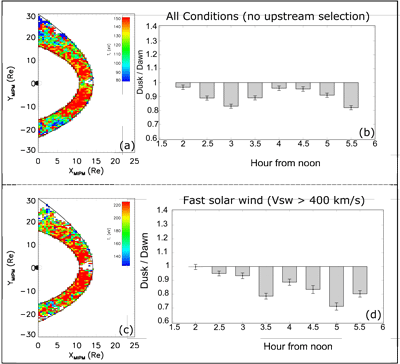
2015 THEMIS SCIENCE NUGGETS
A statistical study of the ion temperature dawn-dusk asymmetry in the terrestrial magnetosheath as a function of solar wind conditions
by Andrew P. Dimmock
Department of Radio Science & Engineering
Aalto University, Finland
Introduction
The expansion of the solar corona continually ejects a stream of charged particles which propagate to the Earth at speeds of around 400 km/s. This stream of plasma is known as the solar wind (SW), and exceeds the local sound speed, thus classifying it as super magneto-sonic. An interplanetary magnetic field (IMF) is also "frozen in" to this plasma whose orientation typically resembles a spiral pattern from the Sun’s rotation. Since its discovery, this magnetic field direction has been known as a Parker spiral, and is the most frequent IMF orientation. When the SW eventually encounters the Earth’s magnetic environment (magnetosphere), it is rapidly slowed to sub-sonic speeds, which subsequently forms a standing shock wave upstream of the planet. Behind this shock wave lies the magnetosheath (MS). The “shocked” plasma in the MS is hotter, denser, slower and more turbulent compared to the SW. The MS extends to another boundary known as the magnetopause, which is maintained by the balance of pressure between the SW plasma and that behind the boundary. Figure 1 below shows an overview of the organisation of these regions and boundaries.
| Figure 1. A diagram illustrating the SW interaction with the Earth’s magnetosphere, in the X-Y plane with the sun at right. The dotted lines show the Parker spiral direction of the IMF which are parallel and perpendicular to the bow shock normal on the dawn and dusk flanks, respectively. |
By function, the MS plays the role of a natural filter or interface between the SW plasma and that inside the inner magnetosphere. The angle measured between the Parker spiral IMF and the direction normal to the shock surface are generally different on each flank, where one side is quasi-parallel (dawn) and another quasi-perpendicular (dusk), please see Figure 1. As a consequence, the plasma is processed slightly differently on each side thus creating some [but not all] parameter and structural dawn-dusk asymmetries. For a variety of upstream SW conditions, it has been shown observationally, and theoretically, that the plasma properties in the MS exhibit asymmetrical behaviour about each flank. By definition, the properties on the dusk flank differ to those of the dawn side. The current highlighted results focus explicitly on the dawn-dusk asymmetry of ion temperatures measured in the dayside MS, their SW dependence, and possible driving mechanisms.
Results
The THEMIS spacecraft consisted of 5 probes [now 3, 2 probes are now the ARTEMIS mission] in equatorial orbits covering the terrestrial magnetosphere. As a result, their comprehensive coverage and orbital bias prove an ideal candidate for a large scale statistical study of MS asymmetries. We recently performed a statistical study of ion temperatures measured by THEMIS to quantify the dawn-dusk asymmetry present under a variety of SW conditions. To account for the substantial motion of the bow shock and MP, each datapoint was normalised between the model boundaries enabling direct comparison between measurements made under different upstream conditions. We then created statistical maps by binning the data onto a uniform grid-space where each grid measures 0.5x0.5 Earth radii (~6353 km). We also compared these observations with kinetic and MHD simulations to determine the physical mechanisms driving the asymmetry. Figures 2a and 2c below show statistical maps created for typical and fast speed SW conditions, respectively. The panels to the right of each map show the dusk/dawn ratio for ion temperatures in the centre of the MS. Therefore, values below 1 indicate a dawn favoured asymmetry and its relative magnitude. In all datasets there is a pronounced dawn favoured asymmetry which varies between 10% and 15% (see Figure 2b). Interestingly, during faster SW speeds the asymmetry appears enhanced as shown in Figure 2c.
| Figure 2. Statistical maps (a, c) and dusk/dawn ratios (b, d) of ion temperatures in the dayside MS for typical parameters, and fast SW conditions. Notice the pronounced asymmetry for both datasets but significantly, there is an enhancement of the asymmetry during faster SW speeds. |
Conclusion
Based on our results, we obtain the following conclusions:
1. Magnetosheath temperatures are 10-15% hotter on the dawn flank compared to those measured on the dusk. (See Figure 2a and 2b)
2. MS temperatures and the magnitude of the dawn favoured asymmetry increased during intervals of fast SW speeds (>400 km/s). See Figure (2b and 2c)
3. There are consistent discrepancies between the observations, and MHD simulations not only for our data, but in previous studies. These are suggestive that ion temperatures in the MS are driven to a large extent by local kinetic processes.
4. In all of our statistical data, the level of dawn-dusk ion temperature asymmetry is insufficient to account for the 30-40% asymmetry in the cold component ions in the cold dense plasma sheet previously reported. This suggests additional heating mechanisms during transport may be present.
Reference
Dimmock, A. P., K. Nykyri, H. Karimabadi, A. Osmane, and T. I. Pulkkinen (2015), A statistical study into the spatial distribution and dawn-dusk asymmetry of dayside magnetosheath ion temperatures as a function of upstream solar wind conditions, J. Geophys. Res. Space Physics, 119, doi:10.1002/2014JA020734.Biographical Note
Andrew Dimmock is a postdoctoral researcher at the Department of Radio Science & Engineering at Aalto University in Finland. His research interests include solar wind - magnetosheath coupling.
 Please send comments/suggestions to
Emmanuel Masongsong / emasongsong @ igpp.ucla.edu
Please send comments/suggestions to
Emmanuel Masongsong / emasongsong @ igpp.ucla.edu


